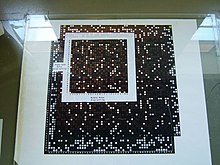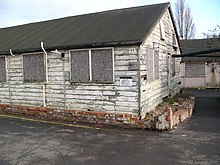John Jeffreys
John Robert Fisher Jeffreys (born January 25, 1916 - January 13, 1944 ) was a British mathematician and cryptanalyst . During the Second World War he contributed significantly to the deciphering of the German rotor key machine Enigma .
Life
John Jeffreys worked in 1939 as a research assistant at Downing College in the English university city of Cambridge . In September of that year, immediately after the German attack on Poland, he was lured away by his former fellow student , the British cryptologist Gordon Welchman , to the Government Code and Cypher School (GC&CS) (German about: "Staatliche Code- und Chiffrenschule"). It was the secret British military agency based in Bletchley Park (BP), which successfully deciphered German communications during World War II. The English city of Bletchley is about 70 km northwest of London in a particularly convenient location between Oxford and Cambridge.

Jeffreys and Welchman, together with Peter Twinn and under the direction of Dillwyn "Dilly" Knox and Alan Turing, formed the research group that dealt intensively with the German key machine Enigma.
Jeffreys was given responsibility for a small team whose job it was to make special perforated sheets. These perforated sheets were then used to determine the roller position and roller position which the German encryptors had used to encrypt their radio messages with the Enigma machine and which were changed daily (“ daily key ”). The deciphering process, which had already been successfully used against the German key machine by the Polish decryption center, the Biuro Szyfrów (German: "Chiffrenbüro"), was based on an idea by the Polish cryptanalyst Henryk Zygalski . It had been revealed to the British by their Polish allies at the secret Pyry meeting in Kabaty Forest , some 20 km south of Warsaw , in July 1939.
The production of the perforated sheets was laborious and time-consuming, because for 17,576 basic positions and 60 roller positions it had to be decided whether a hole was to be cut or not. The holes were hand-cut into large sheets of paper with razor blades. The cryptanalysis and work on this took over three months and could finally be completed on January 7, 1940. Then two complete sets of these perforated sheets (German: "Lochblätter") were available.
According to Welchman, Alan Turing took a set of these sheets with him to France on January 17, 1940 and handed it over to Marian Rejewski's Polish group of cryptanalysts from the former Biuro Szyfrów , who was in exile there. When asked by his Polish colleague Henryk Zygalski, who was surprised at the strange hole size of around 8.5 mm and therefore almost didn't recognize “his” leaves, Turing replied with a laugh: “That's perfectly obvious. It's simply one third of an inch. " (German:" That's very clear. It's just a third of an inch . ")
With the help of the perforated sheets, Polish and British code breakers succeeded in exploiting a serious procedural error made by German cryptographers , namely the so-called " key duplication ". This means that the message key , i.e. the basic position of the Enigma rollers at the beginning of the radio message, identified by three letters, was first doubled to protect against transmission errors and then encrypted with the day key and sent as six letters. Thus the first and fourth, the second and fifth as well as the third and sixth ciphertext letters were each assigned to the same plain text letter. This cryptographic weakness was exposed through the perforated sheets and used for deciphering. One type of perforated sheets were the original Zygalski perforated sheets , which in Bletchley Park were called Zygalski sheets or, for short, a German word called “Netz”. A further development of the perforated sheets, which took into account the effect of two rotating rollers together with the reversing roller , was called " Jeffreys sheets " after John Jeffreys . With these tools, the British code breakers succeeded in deciphering an Enigma radio message for the first time during the Second World War on January 17, 1940, before the first Turing bombs (electromechanical deciphering machines) were put into operation .
In January 1940, the group was formed, which was called Hut Six (German: Barrack 6) after the barracks in which they were housed . Under the direction of Jeffreys and Welchman, Hut 6 dealt specifically with the deciphering of the radio messages encrypted by the German Army and the Air Force with the Enigma I.
Jeffreys took over the responsibility for the sheet stacking room (German: "perforated sheet stacking room ") and the machine room (German: "machine room"), that is, for the perforated sheet and machine-assisted deciphering processes, while Welchman took care of the registry, listening service and deciphering and the cooperation with Hut Three (German: Baracke 3) took care of. The task of the neighboring department Hut 3 was the translation as well as the military-tactical evaluation and interpretation of the German Enigma radio messages deciphered in Hut 6 .
In May 1940, just a few days after the German military changed their process technology on May 15, 1940 and abandoned the previous doubling of the slogan keys and thus the perforated sheets became useless, Jeffreys suddenly fell ill and unexpectedly for all his friends. He was diagnosed with tuberculosis and diabetes at the same time , two diseases he had never suffered from before. Only a few months later, in the spring of 1941, John Jeffreys died.
Gordon Welchman wrote of him:
- “ Jeffreys was very much liked at Bletchley Park. His death was a tragic loss to all of us. We felt deep sympathy for his fianceé, Pat Hempsted, who had been a member of his team from its beginnings in the Cottage. She was involved both in the initial punching of the sheets and in the testing of drops on which our early breaks depended. ”
English: “Jeffreys was very popular in Bletchley Park. His death was a tragic loss for each of us. We felt deeply compassionate for his fiancée, Pat Hempsted, who was part of his team at the cottage from the start . She was involved both in the original punching of the [perforated] sheets and in checking the drops [matches] on which our early break-ins [into the Enigma] depended. "
literature
- Friedrich L. Bauer : Deciphered Secrets. Methods and maxims of cryptology. 3rd, revised and expanded edition. Springer, Berlin et al. 2000, ISBN 3-540-67931-6 .
- Francis Harry Hinsley , Alan Stripp: Codebreakers - The inside story of Bletchley Park . Oxford University Press, Reading, Berkshire 1993. ISBN 0-19-280132-5
- Gordon Welchman : The Hut Six Story - Breaking the Enigma Codes . Allen Lane, London 1982; Cleobury Mortimer M&M, Baldwin Shropshire 2000. ISBN 0-947712-34-8
Web links
- John Jeffreys in the honor roll (Roll of Honor) of Bletchley Park
Individual evidence
- ^ Gordon Welchman: The Hut Six Story - Breaking the Enigma Codes . Allen Lane, London 1982; Cleobury Mortimer M&M, Baldwin Shropshire 2000, p. 11. ISBN 0-947712-34-8
- ^ Gordon Welchman: The Hut Six Story - Breaking the Enigma Codes . Allen Lane, London 1982; Cleobury Mortimer M&M, Baldwin Shropshire 2000, p. 220. ISBN 0-947712-34-8 .
| personal data | |
|---|---|
| SURNAME | Jeffreys, John |
| ALTERNATIVE NAMES | Jeffreys, John Robert Fisher |
| BRIEF DESCRIPTION | British mathematician cryptologist |
| DATE OF BIRTH | January 25, 1916 |
| DATE OF DEATH | January 13, 1944 |



